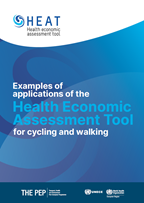Health economic assessment tool (HEAT) for walking and cycling
Promoting walking and cycling means promoting health and protecting the environment. The Health Economic Assessment Tool (HEAT) for walking and cycling is an online tool designed to facilitate evidence-based decision-making towards this goal. Its estimates help assess existing situations, planned projects or past investments in terms of associated health and economic impacts.
HEAT estimates the value of reduced mortality that results from regular walking or cycling by answering the following main question: If x people regularly walk or cycle an amount of y, what is the economic value of the health impacts resulting from the reduction in mortality caused by their physical activity?
E-biking (i.e. electric-assist cycling), bike sharing and conventional cycling (i.e. without electric-assist) can be assessed as separate types of cycling.
These estimates can be further refined by taking into account the mortality effects of exposure to air pollution and traffic crashes while walking or cycling, and/or assessing the changes in carbon emissions resulting from shifting from motorized trips to walking and cycling (including conventional cycling, bike sharing and e-biking).
HEAT for walking and cycling:
- is based on best available evidence, with parameters that can be adapted to fit specific situations worldwide;
- can be part of comprehensive cost–benefit analyses of transport interventions or infrastructure projects; and
- complements existing tools for economic valuations of transport interventions, for example on emissions or congestion.
Who should use HEAT?
HEAT can be used by a wide variety of professionals at both national and local levels, primarily transport planners, traffic engineers and special interest groups working on transport, walking, cycling, public health or the environment.
A methodology and user guide booklet addresses practitioners, policy makers and experts, explaining principles and approaches taken within HEAT to the economic valuation of health impacts related to walking and cycling.
Applications
HEAT has been used in several countries as well as in many scientific publications. It can be applied in many situations. For example:
- to plan a new piece of cycling or walking infrastructure: to assess the impact of increased levels of walking or cycling from putting new infrastructure in place;
- to value the societal mortality impacts from current levels of walking or cycling across a city or in a country; or
- to provide input into more comprehensive cost–benefit analyses or prospective health impact assessments: for instance, to estimate the mortality impacts from achieving national targets to increase walking or cycling, or to illustrate the potential cost consequences of a decline in current levels of walking or cycling.
Acknowledgements
HEAT was developed within the Transport, Health and Environment Pan-European Programme (THE PEP), a joint initiative of WHO/Europe and the United Nations Economic Commission for Europe, with contributions from more than 100 experts from different areas of expertise.
Manual
Publications

Examples of applications of the Health Economic Assessment Tool for cycling and walking
This document presents a selection of 13 illustrative examples of how HEAT can be used, from countries both within and outside the WHO European Region,...







